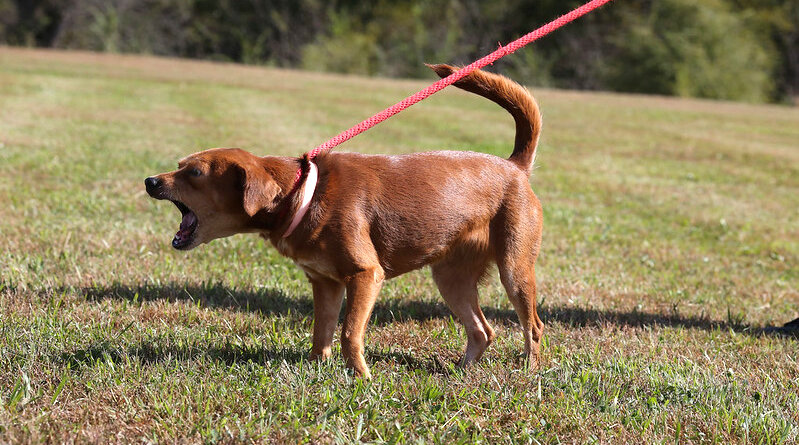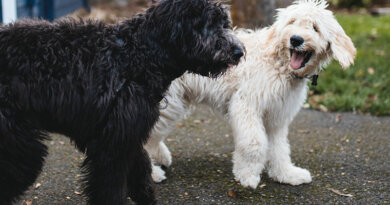How to Manage Leash Reactivity In Your Dog
I adopted my Lab mix Korra at eight weeks old, and followed all of the training books to the T. She was crate trained, she was socialized with all kinds of people, and I brought her everywhere with me and introduced her to new places and new situations, in the hopes that she would be an easy-going, well-dog as she grew into adulthood. Those hopes were dashed when one day, on a walk in a new neighborhood, an off-leash dog jumped a fence and raced towards us, teeth bared. We were able to get away from the situation without injury, but from then on, Korra’s behavior changed. Seemingly overnight, she became uncontrollable, often lunging and barking at the end of her leash whenever she saw another dog. Walks became stressful for me, not enjoyable for her, and with each day her behavior only seemed to get worse.
After two or three months of this with no abatement, we took her to a local trainer, who was able to give us a diagnosis for what was going on: Leash reactivity.
What is leash reactivity?
Dogs can be “reactive” towards any kind of trigger they have a negative association with. In many dogs, the reactivity could look like lunging, barking, or growling. In some dogs, they may show a fearful response or try to run away from the thing that upsets them.
So how does this reactive behavior start? What is going on in a dog’s brain that it feels the need to lash out at another dog or human in such a way? To understand reactivity, it’s first necessary to understand how a dog communicates. It’s natural for a dog to want to communicate with another dog who they see, but dogs communicate quite differently than humans. Dogs prefer to give each other space, to circle around each other, sniff rumps, and then perhaps play, or, if they decide they don’t like each other, get the heck out of each other’s faces!
GET THE BARK IN YOUR INBOX!
Sign up for our newsletter and stay in the know.
What happens when you introduce a leash into the mix? A leash essentially puts a dog in a “cage”—their movements are restricted, largely out of their control, and greetings often occur head-on, face-to-face. There are several reasons why a dog may not like this type of greeting:
Protective behavior: Some dogs get very sensitive or upset when a stranger (human or canine) comes close to their beloved owner.
Frustrated greeter: We’ve already established that a leash interferes with a dog’s natural way of saying hello to another dog. However, instead of being fearful, some dogs get really excited by the prospect of saying hey to another dog—but alas—the leash! The leash gets in the way, and so they get frustrated!
Fear: If a dog develops a fear response to other dogs, this can cause all kinds of distress on walks. Think back to the concept of “leash = cage.” If a dog is fearful of the stimuli in front of her, the leash interrupts their biological “flight” response and doesn’t fully allow them to escape from the thing that’s upsetting them—which can cause even more distress! This was the case for my Korra. As soon as I understood she was reacting of a place of fear, we could move forward with tools to reduce her level of fear.
What Did We Do? Leash Reactive Dog Training
We got to work and with the help of our trainer, we learned all that we could about different force-free protocols for leash reactive dogs. There are multiple protocols out there, but they all boil down to one basic concept: the goal of leash reactivity training is to keep the dog below their threshold of frustration, so they are able to see the thing causes the reactivity, without getting upset. We have to change their reaction to the dog in front of them, but we can only do that if we start them at a place and distance away from the trigger where we know they’re going to succeed.
When we started out on this journey, this meant that the trigger-dog had to be at least on the other side of the street. At this point, she could see the dog, be aware of its presence, but was reassured that it wasn’t an immediate threat to her. Every time she looked at the dog without any signs of stress or reactivity, she would be rewarded. As soon as the dog disappeared from sight, the treats would stop.
Eventually, the idea is that your dog will associate the sight of another dog with a happy event—getting a treat. Gradually over time, your dog will be able to see another dog and react calmly, because she knows that as soon as she does, good things happen! The ultimate goal is to work towards closer distances with your dog, so eventually the dog exhibits fewer stress signals as the dog gets closer and closer. An important note: This is not something to be rushed. Each dog will go at a different pace—any time if you see your dog reacting, exhibiting signs of stress or frustration, you know that you’ve moved too quickly and you’re expecting more from your dog than what they can handle. Back off, and try again at a farther distance.
My Korra is still working on lowering her frustration when we’re on walks, and she’s not always perfect, but she has shown a world of improvement from the fearful, lunging, reactive dog she used to be. It hasn’t been easy and some days I felt like giving up, but because we stuck with it, I have my walking buddy back.





I went over this site and I believe you have a lot of superb information, saved to my bookmarks (:.
cost less pharmacy
Good day very nice blog!! Man .. Beautiful .. Superb .. I’ll bookmark your blog and take the feeds additionallyKI am satisfied to seek out numerous helpful information here within the put up, we want develop more techniques on this regard, thank you for sharing. . . . . .
motilium australia prescription
I appreciate, lead to I discovered just what I was taking a look for. You’ve ended my 4 day long hunt! God Bless you man. Have a great day. Bye
dark web site dark web sites darkmarket
Nearly all of the things you articulate happens to be supprisingly accurate and it makes me ponder the reason why I had not looked at this in this light before. This article truly did switch the light on for me personally as far as this specific subject goes. However at this time there is 1 point I am not really too comfortable with so whilst I attempt to reconcile that with the actual central theme of the point, allow me observe exactly what all the rest of your visitors have to point out.Nicely done.
Great – I should definitely pronounce, impressed with your website. I had no trouble navigating through all the tabs and related info ended up being truly easy to do to access. I recently found what I hoped for before you know it at all. Reasonably unusual. Is likely to appreciate it for those who add forums or something, site theme . a tones way for your client to communicate. Excellent task..
It’s hard to find knowledgeable people on this topic, but you sound like you know what you’re talking about! Thanks
Usually I don’t learn post on blogs, but I would like to say that this write-up very forced me to try and do it! Your writing taste has been surprised me. Thank you, quite great article.
Cuando tenga dudas sobre las actividades de sus hijos o la seguridad de sus padres, puede piratear sus teléfonos Android desde su computadora o dispositivo móvil para garantizar su seguridad. Nadie puede monitorear las 24 horas del día, pero existe un software espía profesional que puede monitorear en secreto las actividades de los teléfonos Android sin avisarles.
I think you have remarked some very interesting points, thanks for the post.